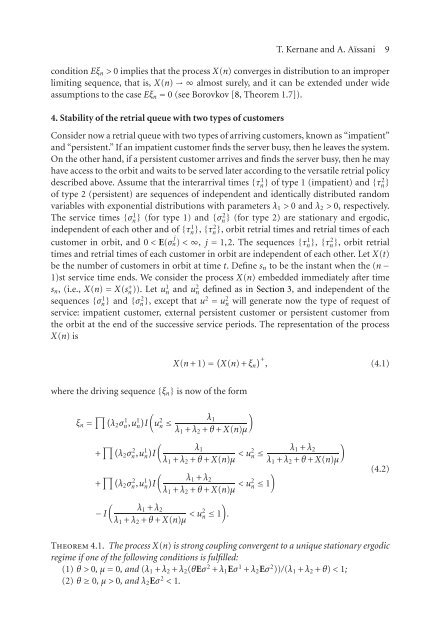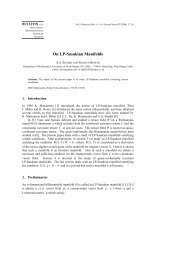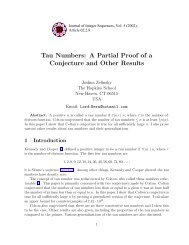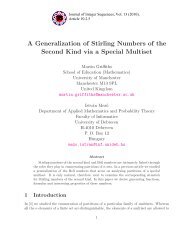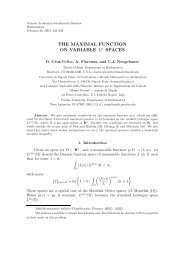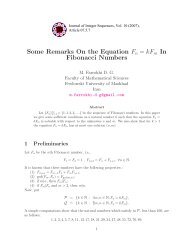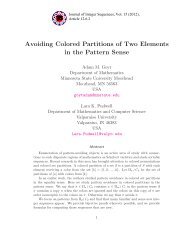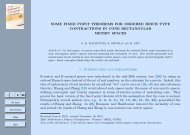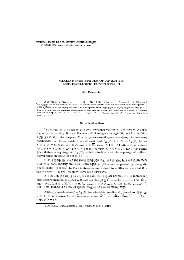stability of retrial queues with versatile retrial policy - European ...
stability of retrial queues with versatile retrial policy - European ...
stability of retrial queues with versatile retrial policy - European ...
You also want an ePaper? Increase the reach of your titles
YUMPU automatically turns print PDFs into web optimized ePapers that Google loves.
T. Kernane and A. Aïssani 9condition Eξ n > 0 implies that the process X(n) converges in distribution to an improperlimiting sequence, that is, X(n) →∞almost surely, and it can be extended under wideassumptions to the case Eξ n = 0 (see Borovkov [8, Theorem 1.7]).4. Stability <strong>of</strong> the <strong>retrial</strong> queue <strong>with</strong> two types <strong>of</strong> customersConsider now a <strong>retrial</strong> queue <strong>with</strong> two types <strong>of</strong> arriving customers, known as “impatient”and “persistent.” If an impatient customer finds the server busy, then he leaves the system.On the other hand, if a persistent customer arrives and finds the server busy, then he mayhave access to the orbit and waits to be served later according to the <strong>versatile</strong> <strong>retrial</strong> <strong>policy</strong>described above. Assume that the interarrival times {τn 1} <strong>of</strong> type 1 (impatient) and {τ2 n }<strong>of</strong> type 2 (persistent) are sequences <strong>of</strong> independent and identically distributed randomvariables <strong>with</strong> exponential distributions <strong>with</strong> parameters λ 1 > 0andλ 2 > 0, respectively.The service times {σn 1} (for type 1) and {σ2 n } (for type 2) are stationary and ergodic,independent <strong>of</strong> each other and <strong>of</strong> {τn 1}, {τ2 n }, orbit <strong>retrial</strong> times and <strong>retrial</strong> times <strong>of</strong> eachcustomer in orbit, and 0 < E(σn) j < ∞, j = 1,2. The sequences {τn}, 1 {τn}, 2 orbit <strong>retrial</strong>times and <strong>retrial</strong> times <strong>of</strong> each customer in orbit are independent <strong>of</strong> each other. Let X(t)bethenumber<strong>of</strong>customersinorbitattimet. Defines n to be the instant when the (n −1)st service time ends. We consider the process X(n) embedded immediately after times n , (i.e., X(n) = X(s + n)). Let u 1 n and u 2 n defined as in Section 3, and independent <strong>of</strong> thesequences {σn 1} and {σ2 n },exceptthatu2 = u 2 n will generate now the type <strong>of</strong> request <strong>of</strong>service: impatient customer, external persistent customer or persistent customer fromthe orbit at the end <strong>of</strong> the successive service periods. The representation <strong>of</strong> the processX(n)isX(n +1)= ( X(n)+ξ n) +, (4.1)where the driving sequence {ξ n } is now <strong>of</strong> the formξ n = ∏ )(λ2 σn,u 1 1 )n I(u 2 n ≤ λ 1λ 1 + λ 2 + θ + X(n)μ+ ∏ ()(λ2 σn,u 2 1 ) λn I 1λ 1 + λ 2 + θ + X(n)μ


